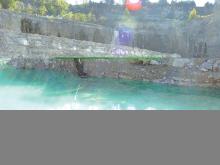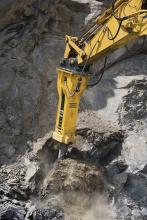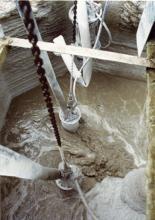
Many quarry operators opt for pumps with long-used designs rather than looking for newer alternatives that could offer cost and efficiency savings. Claire Symes reports
Limited access to new mineral resources in Europe means that quarry operators have to quarry deeper at existing sites or work in less than ideal conditions. In many cases this involves managing ground water on site effectively to allow work to continue, but while minimising environmental impact.
According to
"There is a culture in the quarrying sector to replace a worn out pump with a similar new unit rather than looking at what else is available," said Paz. "There have been some significant advances in design in recent years and by re-evaluating the pumping needs in a quarry, the operation could be improved and also cost reduced by adopting an alternative solution." There are three main types of pumps used in European quarries - vertical turbine pumps, electric submersible pumps and automatic self priming centrifugal pumps. Each has advantages and disadvantages, which according to Paz means that the pumping solution can be tailored to meet the demands of the quarry, in terms of operational and maintenance costs and initial outlay.
"Operators need to look at how they balance the initial investment to the operational and maintenance costs. A pump which has a lower initial cost may not be as reliable of offer as much up time as a more expensive one. It is a balance between reliability and longevity versus cost," he said. "They also need to consider the flow rates, head height and actual running costs of the pump.
"Other factors that will drive the choice include how and where the pump is to be located. Both vertical turbine pumps and electric submersible pumps need to be submersed, which may cause maintenance issues, whereas an automatic self-priming centrifugal pump is sited above the water. Height of the lift wall and proximity to the power supply also need to be considered." In addition to the cost of investment and operation and ease of maintenance, the volume of water to be pumped needs to be considered as well as the potential for abrasive solids within the liquid.
According to Paz, electric submersible pumps are generally the cheapest option, whereas self-priming pumps are more of a long term investment.
"Electric submersible have the lowest original cost and also have the benefit of being easily portable and easy to install," he said. However, they have the lowest resistance to wear, so are best suited to applications where pumping water out of the quarry is not an ongoing issue and the pump is not needed to run continuously.
"Vertical turbine pumps are a low cost solution and if they have a multiple stage pump, can offer high efficiency with a high water flow compared to the power consumption. But they are more difficult to install and reliability is often lower than with other pumping options," said Paz.
"Automatic self-priming centrifugal pumps have the highest original cost but are the best solution in terms of efficiency and reliability. One of the main benefits is that they are positioned out of the water, which makes monitoring of performance and wear very easy - a technician can dismantle it, check for wear and have it back working within an hour."
Technology
While some pump designs have been around for the last 20 to 30 years and still perform well, there has been significant innovation in the sector in the last few years.
Improved designs through computer aided design and better materials have enabled manufacturers to achieve much higher lift capabilities from single stage pumps than was ever previously possible. "Lifts of over 200m are now possible with one pump, whereas in the past three pumps may have been needed to take the water out of the quarry," said Paz. "This is an important development for the aggregates industry as it is allowing quarry operators to manage their pumping needs more efficiently even though many quarries are getting deeper and deeper." The ability to pump higher heads has come from improvements and refinements to the designs of the impellors and volutes, as well as stronger materials which are better able to resist wear and withstand higher pressures.
Paz said that another significant development was the wider use of close coupling, which has helped to improve reliability. "With conventionally coupled pumps, you have the pump and the
prime mover (engine) joined by a coupling shaft," he explained. "This adds potential for misalignment despite the use of self aligning and laser alignment systems." Alignment problems can cause loss of efficiency through to long term damage to either the engine or pump. Close coupling - linking the shaft directly onto the engine's flywheel - removes the risk of misalignment, offing better reliability.
"Close coupling has become popular on smaller pumps but the technology is developing and is spreading to larger units now," said Paz.
Improved designs are also helping to lower the maintenance requirements of pumps used in quarries. Better oil lube bearings, oil seals and sub bearings have helped to lengthen the maintenance interval on some pumps from 100hours to 500hours.
According to Paz, Global Positioning Systems (GPS) will be the next development for the pump industry. "It is already available for some installations but is being perfected at the moment and will offer better monitoring and operational capabilities," he said.
Most large pumps now have Stage IIIA/Tier 3 engines fitted to meet emissions regulations. Such engines have ECM which offers the capability to link the pump to a quarry's asset network and allow transfer of real time performance information.
"Linking a pump via GPS will allow remote monitoring of oil temperature and pressure, as well as pump performance," said Paz. "Careful checking of the pressure against the flow rate will allow operators to plan preventative maintenance before breakdowns occur. As the pump wears, the pressure reduces, limiting the maximum flow rate that the pump is capable of.
"But in addition to remote monitoring, addition of GPS will allow the pump to be controlled remotely. The pump can be fitted with a variable frequency control to allow the pump speed to be increased to maintain the flow and counteract the wear.
"Such systems are ideal for quarries where once the water is lowered to a sufficient level to allow extraction work, the pump speed can be lowered to reduce the flow and maintain the water level. The main advantage is that it keeps the pump operating continuously - it is the starting and stopping of pumping that causes the most wear."
Demand
According to Paz, demand for pumps for quarry applications in Europe is growing, particularly in Eastern Europe and Russia. "Demand in Western Europe is stable but is larger in terms of volume," said Paz. "Further growth is likely in Eastern Europe over the next few years as operators look to improve efficiency and update equipment to meet growing aggregate demand."









